It was six years in the making, only a few days in the unmaking.
One of Fort Worth’s handsomest public buildings for sixty-seven years was the 1896 federal building/post office.
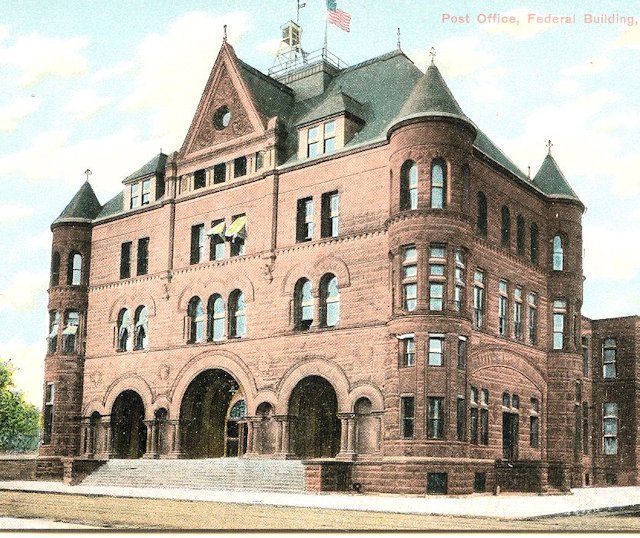 This postcard shows that the federal building/post office, built of rusticated red Pecos sandstone, had a gray slate roof with dormers, corner turrets with finials, ornate center gable with oculus, and arched windows and entries.
This postcard shows that the federal building/post office, built of rusticated red Pecos sandstone, had a gray slate roof with dormers, corner turrets with finials, ornate center gable with oculus, and arched windows and entries.
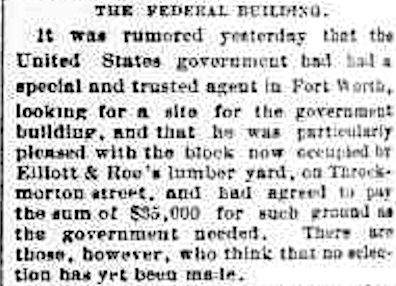 In 1890 the March 4 Fort Worth Gazette reported that a federal government agent had been in town looking for a site on which would be built a federal building. The agent had his eye on the Elliott & Roe lumber yard (where in 1907 the killer of County Attorney Jefferson Davis McLean would be fatally wounded in a shootout with police). The Gazette soon began an almost daily speculation about the “where?”s and “when?”s and “how big?”s of the project.
In 1890 the March 4 Fort Worth Gazette reported that a federal government agent had been in town looking for a site on which would be built a federal building. The agent had his eye on the Elliott & Roe lumber yard (where in 1907 the killer of County Attorney Jefferson Davis McLean would be fatally wounded in a shootout with police). The Gazette soon began an almost daily speculation about the “where?”s and “when?”s and “how big?”s of the project.
 But by September it was rumored that the federal building/post office would be built on or adjacent to the lot occupied by the gasworks (Commerce and East 10th streets), which was in Hell’s Half Acre. In a letter to the editor “A Business Man” decried the sin of the Acre and suggested that its “inherent evils” be relocated from downtown. As for placing the new federal building in the Acre, he asked, “Are we willing to have our families go there to the postoffice?” Clip is from the September 1 Gazette.
But by September it was rumored that the federal building/post office would be built on or adjacent to the lot occupied by the gasworks (Commerce and East 10th streets), which was in Hell’s Half Acre. In a letter to the editor “A Business Man” decried the sin of the Acre and suggested that its “inherent evils” be relocated from downtown. As for placing the new federal building in the Acre, he asked, “Are we willing to have our families go there to the postoffice?” Clip is from the September 1 Gazette.
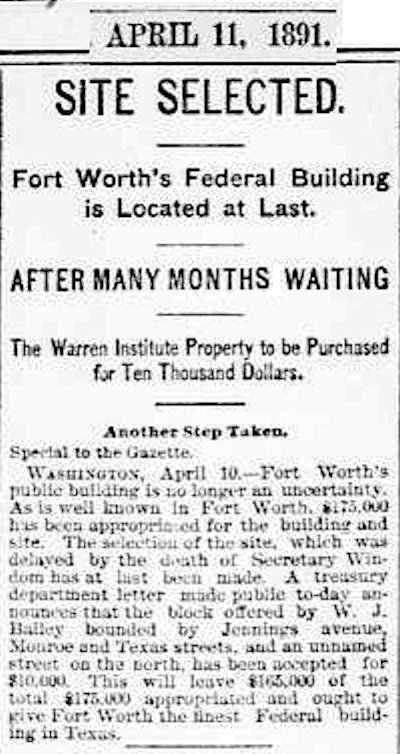 Not to worry. On April 11, 1891 the Gazette reported that the site selected was on Jennings Avenue at Texas Street. That meant that St. Patrick’s Cathedral would soon stand as a shield between the post office and the sin of Hell’s Half Acre.
Not to worry. On April 11, 1891 the Gazette reported that the site selected was on Jennings Avenue at Texas Street. That meant that St. Patrick’s Cathedral would soon stand as a shield between the post office and the sin of Hell’s Half Acre.
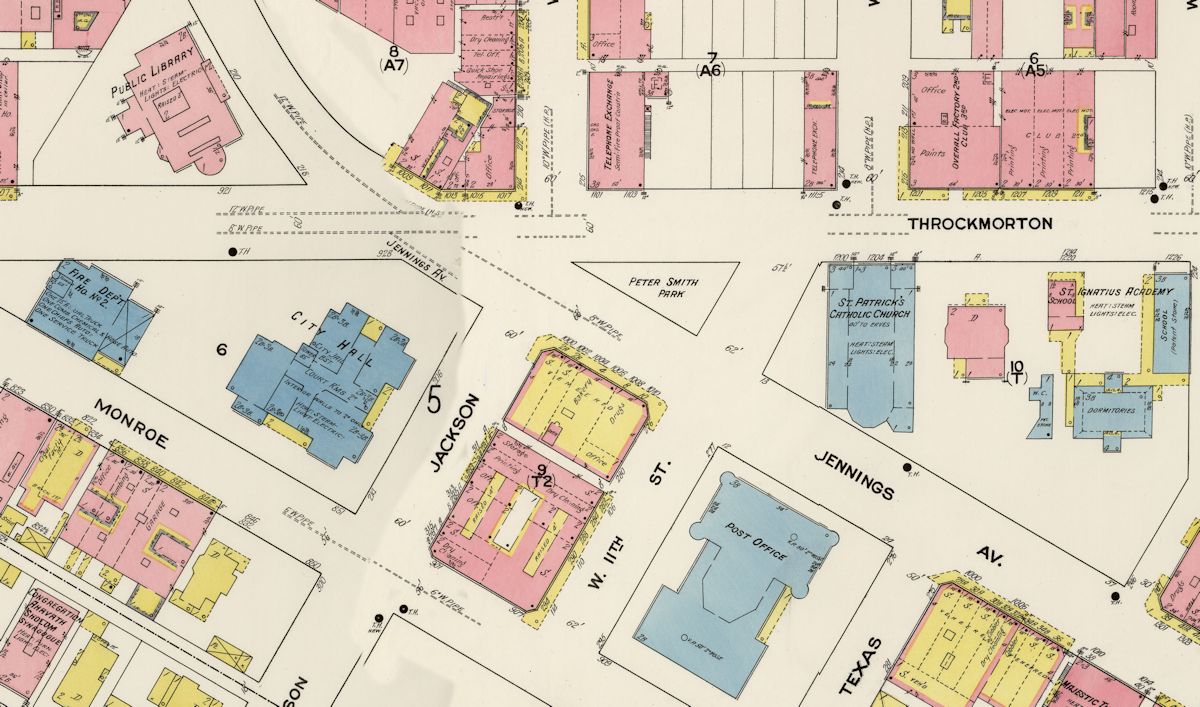 In 1910 this small area of downtown was a showcase of stone architecture: the Carnegie library, the central fire hall, city hall, federal building/post office, the telephone building, and the St. Patrick’s compound, with the cathedral and St. Ignatius Academy.
In 1910 this small area of downtown was a showcase of stone architecture: the Carnegie library, the central fire hall, city hall, federal building/post office, the telephone building, and the St. Patrick’s compound, with the cathedral and St. Ignatius Academy.
 This 1928 aerial photo shows 1. federal building/post office, 2. city hall, 3. central fire hall, 4. Carnegie library, 5. telephone building, 6. St. Patrick’s.
This 1928 aerial photo shows 1. federal building/post office, 2. city hall, 3. central fire hall, 4. Carnegie library, 5. telephone building, 6. St. Patrick’s.
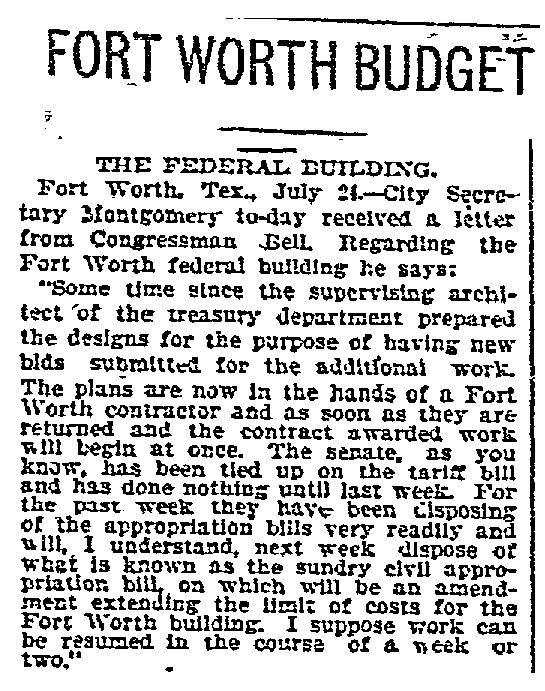 In the beginning there was more red tape than red sandstone. Although a site was selected in 1891 and federal funds appropriated in 1892, the building was not completed until 1896. Part of the delay came because the design for the building was changed from two stories to three, and extra funds had to be appropriated in Washington.
In the beginning there was more red tape than red sandstone. Although a site was selected in 1891 and federal funds appropriated in 1892, the building was not completed until 1896. Part of the delay came because the design for the building was changed from two stories to three, and extra funds had to be appropriated in Washington.
On July 25, 1894 the Dallas Morning News reported on the plans to build the building. The supervising architect of the U.S. Treasury designed the building.
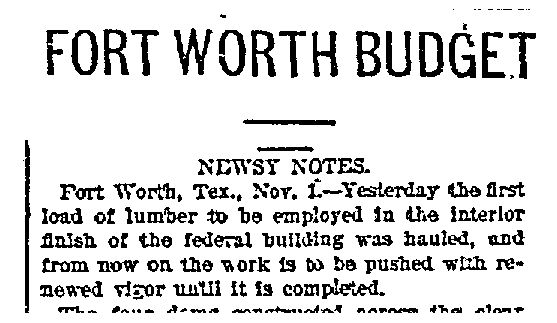 On November 2, 1895 the Morning News reported that the first load of lumber for the interior of the new building had arrived.
On November 2, 1895 the Morning News reported that the first load of lumber for the interior of the new building had arrived.
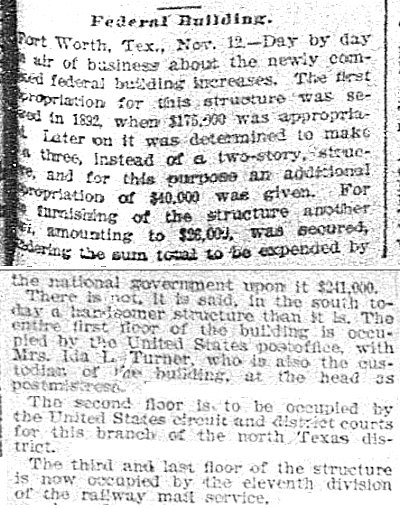 On November 13, 1896 the Morning News reported on the status of the new building, finally open for business. The building was built for $241,000 ($6.5 million today). The Morning News wrote, “There is not, it is said, in the south today a handsomer structure.” The building was a jack-of-all-trades. On the first floor was the federal post office. On the second floor would be the U.S. circuit and district courts for the northern district of Texas. The third floor housed the Railway Mail Service. The attic housed a weather station. The weather instruments were mounted on the roof. In the days before radio and TV a weather bureau employee “broadcast” the weather forecast to pedestrians by a set of flags raised on a pole on the roof of the building (see postcard above).
On November 13, 1896 the Morning News reported on the status of the new building, finally open for business. The building was built for $241,000 ($6.5 million today). The Morning News wrote, “There is not, it is said, in the south today a handsomer structure.” The building was a jack-of-all-trades. On the first floor was the federal post office. On the second floor would be the U.S. circuit and district courts for the northern district of Texas. The third floor housed the Railway Mail Service. The attic housed a weather station. The weather instruments were mounted on the roof. In the days before radio and TV a weather bureau employee “broadcast” the weather forecast to pedestrians by a set of flags raised on a pole on the roof of the building (see postcard above).
The building also housed offices of the U.S. marshal, probation officers, immigration and customs agents, and, during Prohibition, agents investigating violations of the Volstead Act.
The building also housed the office of the U.S. commissioner, before whom in 1916 “the last Rebel” took the oath of allegiance to the Union.
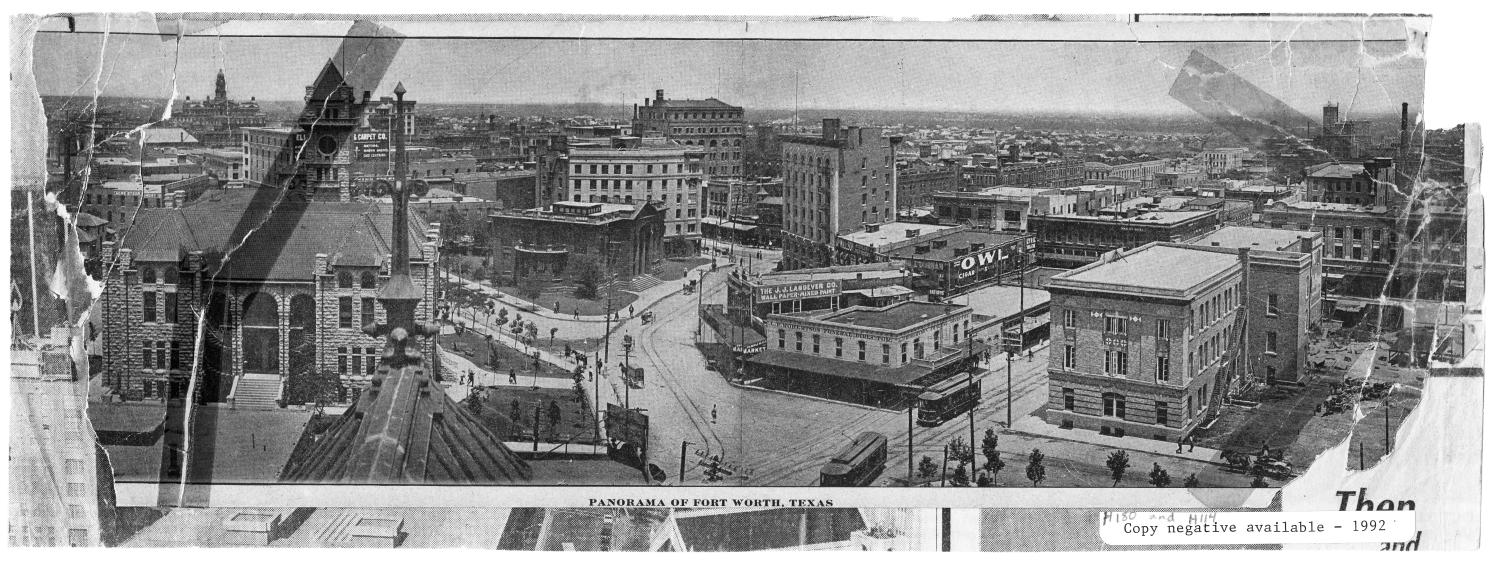 Photographers loved to take photos from the roof of the federal building. This tattered panorama (circa 1908) includes, from left, the 1893 city hall, Carnegie library, Western National Bank, Flatiron Building, Texas Brewing Company, and telephone building. Note the horse cart, Owl cigars wall sign, and streetcars. (Photo from University of Texas at Arlington Library.)
Photographers loved to take photos from the roof of the federal building. This tattered panorama (circa 1908) includes, from left, the 1893 city hall, Carnegie library, Western National Bank, Flatiron Building, Texas Brewing Company, and telephone building. Note the horse cart, Owl cigars wall sign, and streetcars. (Photo from University of Texas at Arlington Library.)
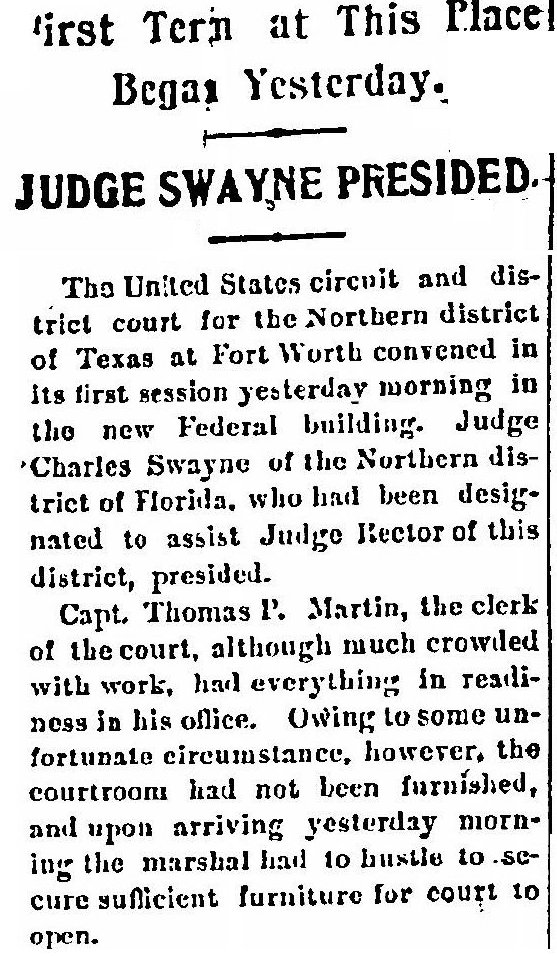 Although the post office and Railway Mail Service had moved into the new building in 1896, on March 2, 1897 the Fort Worth Register reported that the U.S. circuit and district courts for the northern district of Texas did not convene their first session in the new building until March 1, 1897.
Although the post office and Railway Mail Service had moved into the new building in 1896, on March 2, 1897 the Fort Worth Register reported that the U.S. circuit and district courts for the northern district of Texas did not convene their first session in the new building until March 1, 1897.
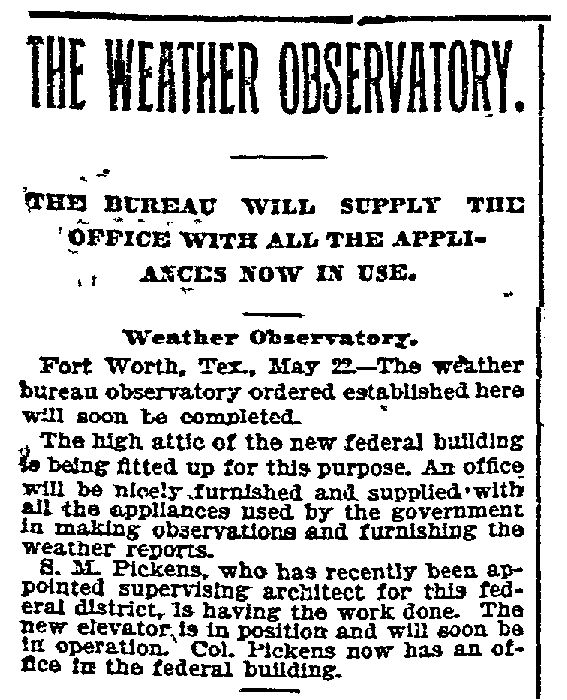 On May 23, 1897 the Register reported that the weather observatory would soon be completed.
On May 23, 1897 the Register reported that the weather observatory would soon be completed.
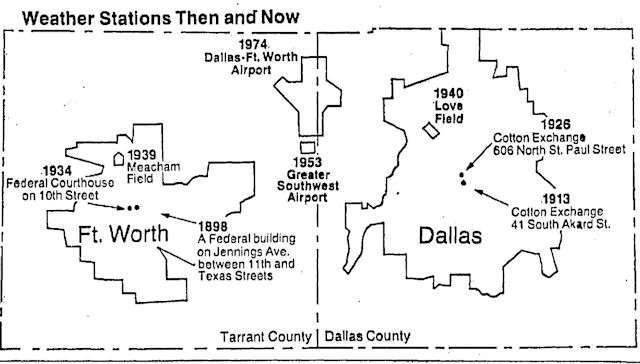 A June 30, 1974 Morning News graphic shows that the federal building/post office was the first weather station in the area. The instruments on the roof can be seen in the postcard.
A June 30, 1974 Morning News graphic shows that the federal building/post office was the first weather station in the area. The instruments on the roof can be seen in the postcard.
 In 1909 a two-story addition for the post office was built on the rear of the building.
In 1909 a two-story addition for the post office was built on the rear of the building.
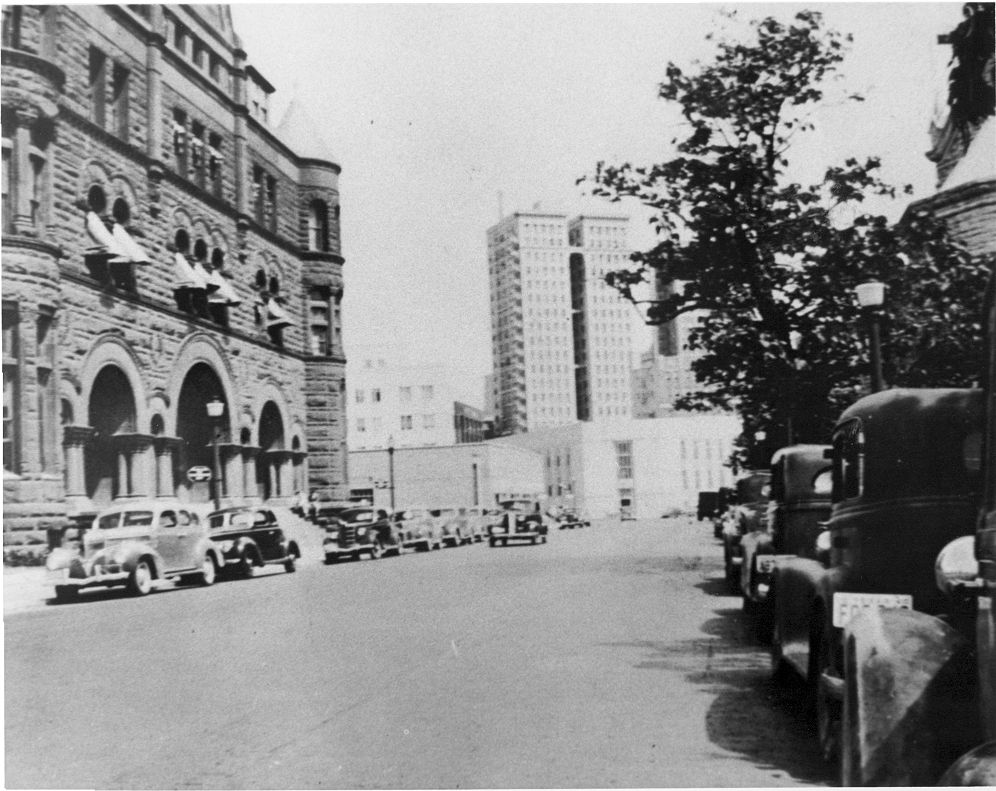 The front of the federal building looking north on Jennings toward the Waggoner Building, 1938 city hall, and 1939 public library. (Photo from Tarrant County College NE, Heritage Room.)
The front of the federal building looking north on Jennings toward the Waggoner Building, 1938 city hall, and 1939 public library. (Photo from Tarrant County College NE, Heritage Room.)
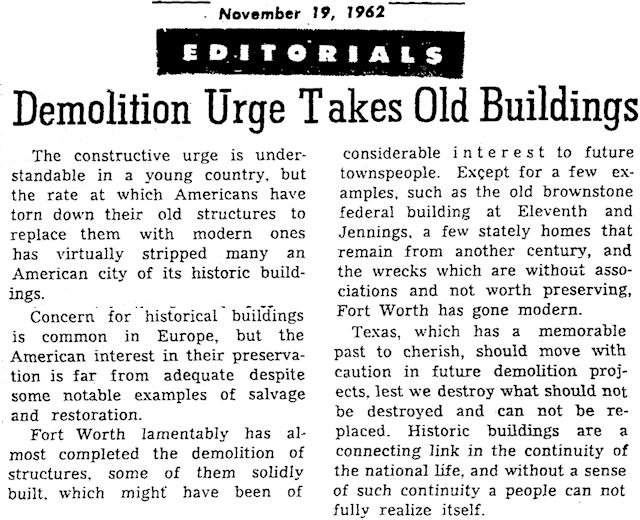 In 1933 Fort Worth got a new post office and a new federal courthouse. In 1937 the federal government sold the 1896 building to the city. In 1962 the city said the old building was in bad shape and not worth saving. But the Star-Telegram in an editorial singled out “the old brownstone federal building” in a plea for preservation of historic buildings. The Tarrant County Historical Society also tried to save the old building, but a year later . . .
In 1933 Fort Worth got a new post office and a new federal courthouse. In 1937 the federal government sold the 1896 building to the city. In 1962 the city said the old building was in bad shape and not worth saving. But the Star-Telegram in an editorial singled out “the old brownstone federal building” in a plea for preservation of historic buildings. The Tarrant County Historical Society also tried to save the old building, but a year later . . .
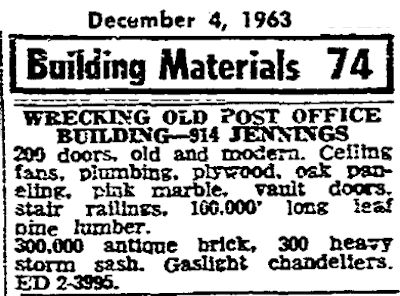 A wrecking ball gave the old sandstone federal building the kiss of death, and it was history. Its oak paneling, pink marble, gaslight chandeliers, antique brick were cannibalized as the building was torn down to make way for a . . . wait for it . . . parking lot. Again asphalt had trumped aesthetics.
A wrecking ball gave the old sandstone federal building the kiss of death, and it was history. Its oak paneling, pink marble, gaslight chandeliers, antique brick were cannibalized as the building was torn down to make way for a . . . wait for it . . . parking lot. Again asphalt had trumped aesthetics.
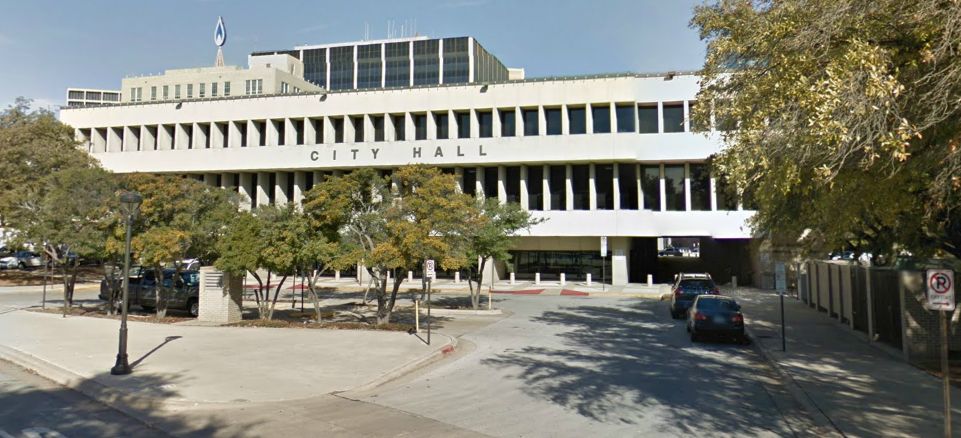 In 1971 the mundane replaced the magnificent when the current city hall was opened on the site. (In 1968 Edward Durell Stone, co-architect with Preston Geren, had said of their design for the new city hall, “You’ve got a fine building. As the modern generation would say, it’s a swinger.”)
In 1971 the mundane replaced the magnificent when the current city hall was opened on the site. (In 1968 Edward Durell Stone, co-architect with Preston Geren, had said of their design for the new city hall, “You’ve got a fine building. As the modern generation would say, it’s a swinger.”)
Today if you want to see anything closely resembling our Old Red, you have to go thirty miles east, where Dallas has chosen to preserve its Old Red, the 1892 courthouse, also built of red Pecos sandstone (images from Wikipedia):
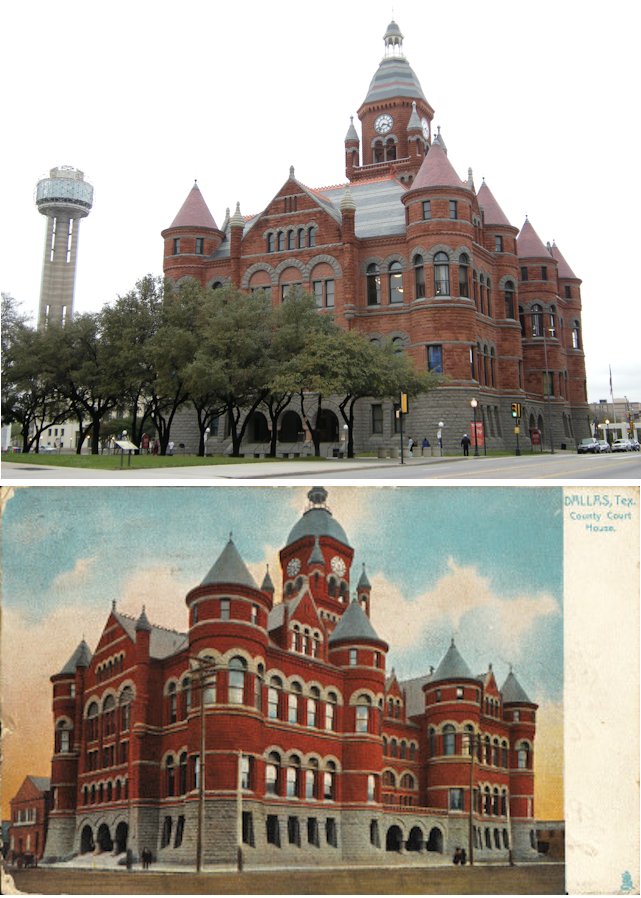






I have thoroughly enjoyed your story. I came across this reference via ancestry.com. My 2nd Great Grandfather was Edward Lewis Evans who was involved in the masonry work. He had an illustrious career in construction apparently mostly in the railroad station construction area. I am interested in any additional resources or references you might have that would shed more light on George H. Evans, Henry Oliver Evans and Edward Lewis Evans who were contracted to work on building “Old Red”. Thank you!
Thank you, Ms. Smith. The only resources I have for that story are newspapers of the time, and they were never much interested in who designed or built our public buildings.
Thanks Mike. I was not aware of the “federal building” at that site. In the mid 70s Carolyn worked at that city hall building, and I worked at the relatively new Federal Building (Region 7 of 10, GSA headquarters for Texas and adjacent states) across the street. Very convenient for carpooling, ha. Good story (love the picture from the roof top)
I don’t remember it either. But it was there into our early teens. I am not sure you could come out of the library without seeing it. But I seem to have managed to.
I love your work and “pictures”. Please continue.
Thanks, Marian. For two years I have been vowing to give up it, but every morning I wake up and wonder about something new.
Please don’t stop your blog and the information you give us. I enjoy it so much and always read every new post. Unfortunately, I just became aware of it a few months ago. I am sure I have missed a lot by not finding out sooner about your blog. I ordered your book, Lost Fort Worth, and read it. Fascinating and enjoyable! Thanks for all your work and for providing it for us all to read.
Thank, Anita. After working on this blog for almost four years like it was a paying job, I am adding to it less often. But the blog will continue to be online. It’s set up to be self-serve. There are categories for the 800 posts and 6,000 images, a Top 10 list, links to my hometown video clips. And the blog can be searched by keywords. Help yourself.
Do you know who was the architect on the building? M.A Orloop from Little Rock, Arkansas, did the Old Red Courthouse. The Old Red sandstone came from Pecos. I wonder if the Feds used the same material. I recall that some red sandstone from a building in Fort Worth was used in repairs of Old Red in the 70’s or 80’s.
Daniel, from my reading of the “Gazette,” the supervising architect in D.C. was W. T. Eubanks. But there was also a supervising architect “on the ground” in Fort Worth. Apparently he was first a Mr. Brownlee, who was replaced in 1893 by S. M. Pickens. I have seen a sketch of the building being demolished but have no idea if any of the sandstone was salvaged and later went to good use in the Dallas Old Red. What a great “giving life after death” story that would be.